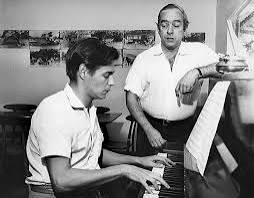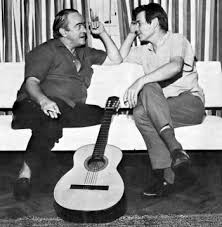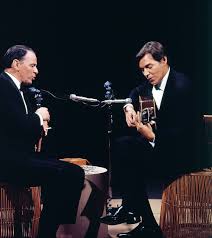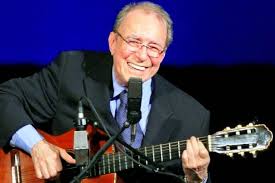 Bossa nova is the term by which a movement for the renewal of samba radiated from the South Zone of the city of Rio de Janeiro in the late 1950s. The rythem became known and which came to give its name to the style of interpretation and rhythmic accompaniment and was a kind of simplification of the beat of the samba school.
Bossa nova is the term by which a movement for the renewal of samba radiated from the South Zone of the city of Rio de Janeiro in the late 1950s. The rythem became known and which came to give its name to the style of interpretation and rhythmic accompaniment and was a kind of simplification of the beat of the samba school.
Thus, the starting point of bossa nova is the samba “Chega de Saudade” (written by Tom Jobim and Vinicius de Moraes), originally released by Elizeth Cardoso in 1958 and, shortly after, by João Gilberto, who played the guitar in both recordings.
At the same time, pianist and vocalist Johnny Alf, since recording “Rapaz de bem”, a song marked by the influence of jazz, also became one of the pioneers of the renewal of samba at that time.
 In 1959, with the album “Chega de Saudade”, Joao Gilberto consolidated this new style of playing that altered harmonies with the introduction of unconventional chords. From and around João Gilberto, a group of musicians, almost all of them from the middle class and with university education, would help to transform the formal experiences of the guitarist from Bahia.
In 1959, with the album “Chega de Saudade”, Joao Gilberto consolidated this new style of playing that altered harmonies with the introduction of unconventional chords. From and around João Gilberto, a group of musicians, almost all of them from the middle class and with university education, would help to transform the formal experiences of the guitarist from Bahia.
From the 1960s onwards, bossa nova samba definitively consolidated itself in the Brazilian music scene, where, in addition to Gilberto and the duo Tom and Vinícius, names such as Newton Mendonça, Billy Blanco, Aloysio de Oliveira, Baden Powell stood out , Oscar Castro Neves, Carlos Lyra, Ronaldo Bôscoli, Roberto Menescal, Sérgio Mendes, César Camargo Mariano, Airto Moreira, Eumir Deodato, Milton Banana, João Donato, among several, in addition to the emergence of numerous vocal groups, such as Os Cariocas, or instrumentals , like Bossa Três, among others.
It was at that same moment that the style experienced an international projection on a scale never seen with any other aspect of Brazilian popular music. In 1962, saxophonist Stan Getz together with guitarist Charlie Byrd released the album “Jazz Samba”, which brought bossa nova to the attention of the music industry in the United States.
 That same year, a concert at Carnegie Hall in New York, which brought together Tom Jobim and João Gilberto, among others, once and for all opened the doors of the world to the style. The following year, with the release of the album Getz/Gilberto, a partnership between the Brazilian guitarist and the American saxophonist, it became known worldwide, in addition to winning the Grammy Award for album of the year 1965.
That same year, a concert at Carnegie Hall in New York, which brought together Tom Jobim and João Gilberto, among others, once and for all opened the doors of the world to the style. The following year, with the release of the album Getz/Gilberto, a partnership between the Brazilian guitarist and the American saxophonist, it became known worldwide, in addition to winning the Grammy Award for album of the year 1965.
Two years later, under the title “ The girl from Ipanema”, English version of the famous samba Garota de Ipanema, by Tom and Vinicius, was recorded by Frank Sinatra.
However, in the mid-sixties, the bossa-nova movement was undergoing a split. On one hand, a group remained faithful to the light aesthetic, characterized by lyrics with mild themes and uncommitted to the Brazilian reality or any kind of social participation, by the soft and intimate tone (personalized in the voice of João Gilberto) and the strong influence of jazz.
On the other hand, another group formed by composers such as Baden Powell, Sergio Ricardo and Carlos Lyra and by lyricists such as Vinicius de Moraes and Nelson Lins e Barros joined the general movement of Brazilian culture in order to seek a popular base in music and a theme of realism and social participation in the lyrics.
 It was this dissidence that established an important connection between bossa nova samba and popular samba, generally known as “do morro” or “de root”, making names such as Cartola, Nelson Cavaquinho, Zé Keti and Elton Medeiros — prestigious samba musicians in the middle of the “root samba”, but excluded from the phonographic market of the time — would become known by a slice of the young and university public.
It was this dissidence that established an important connection between bossa nova samba and popular samba, generally known as “do morro” or “de root”, making names such as Cartola, Nelson Cavaquinho, Zé Keti and Elton Medeiros — prestigious samba musicians in the middle of the “root samba”, but excluded from the phonographic market of the time — would become known by a slice of the young and university public.
It is in this new context that the Brazilian artistic scene has seen the emergence of a new generation of composers, such as Paulinho da Viola, seen there as a successor to Noel Rosa or Ismael Silva, and Chico Buarque, author of compositions that would soon become anthological sambas.